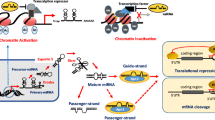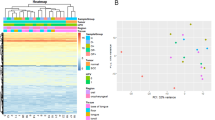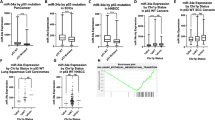Abstract
Background
Head and neck squamous cell carcinoma (HNSCC) is the sixth most common cause of cancer mortality in the world and the 5th most commonly occurring cancer. Tobacco smoking, alcohol consumption and human papilloma virus (HPV) infections have been associated with the occurrence of HNSCC. Despite advances that have been made in HNSCC treatment, smoking-associated HNSCC patients still exhibit a poor 5 year survival rate (30–50 %) and a concomitant poor quality of life. The major clinical challenge to date lies in the early detection of dysplastic lesions,which can progress to malignancy. In addition, there are currently no tools available to monitor HNSCC patients for early stages of local recurrences or distant metastases. In the recent past, micro-RNAs (miRNA) have been assessed for their role in cancer initiation and progression, including HNSCC. It is now well-established that deregulation of these single stranded, small non-coding, 19–25 nt RNAs can e.g. enhance the expression of oncogenes or subdue the expression of tumor suppressor genes. The aims of this review are three-fold: first to retrieve from the literature miRNAs that have specifically been associated with HNSCC, second to group these miRNAs into those regulating tumor initiation, progression and metastasis, and third to discern miRNAs related to smoking-associated HNSCC versus HPV-associated HNSCC development.
Conclusions
This review gives an overview on the miRNAs regulating the development of head and neck cancers. The ultimate establishment of miRNA expression profiles that are HNSCC specific, and miRNAs that orchestrate altered gene and protein expression levels in HNSCC, could pave the way for a better understanding of the mechanism underlying its pathogenesis and the development of novel, targeted therapies.


Similar content being viewed by others
References
T. Du, P.D. Zamore, microPrimer: The biogenesis and function of microRNA. Development 132(21), 4645–52 (2005)
H.W. Hwang, J.T. Mendell, MicroRNAs in cell proliferation, cell death, and tumorigenesis. Br J Cancer 94(6), 776–80 (2006)
A.H. Williams et al., MicroRNA control of muscle development and disease. Curr Opin Cell Biol 21(3), 461–9 (2009)
M. Carleton, M.A. Cleary, P.S. Linsley, MicroRNAs and cell cycle regulation. Cell Cycle 6(17), 2127–32 (2007)
E. Berezikov et al., Phylogenetic shadowing and computational identification of human microRNA genes. Cell 120(1), 21–4 (2005)
J.V. Tricoli, J.W. Jacobson, MicroRNA: Potential for cancer detection, diagnosis, and prognosis. Cancer Res 67(10), 4553–5 (2007)
S. Vasudevan, Y. Tong, J.A. Steitz, Switching from repression to activation: microRNAs can up-regulate translation. Science 318(5858), 1931–4 (2007)
R.F. Place et al., MicroRNA-373 induces expression of genes with complementary promoter sequences. Proc Natl Acad Sci U S A 105(5), 1608–13 (2008)
J. Lu et al., MicroRNA expression profiles classify human cancers. Nature 435(7043), 834–838 (2005)
X.B. Long et al., Let-7a microRNA functions as a potential tumor suppressor in human laryngeal cancer. Oncol Rep 22(5), 1189–95 (2009)
T.D. Schmittgen, miR-31: A master regulator of metastasis? Future Oncol 6(1), 17–20 (2010)
S. Valastyan et al., A pleiotropically acting microRNA, miR-31, inhibits breast cancer metastasis. Cell 137(6), 1032–46 (2009)
N. Yanaihara et al., Unique microRNA molecular profiles in lung cancer diagnosis and prognosis. Cancer Cell 9(3), 189–98 (2006)
J. Takamizawa et al., Reduced expression of the let-7 microRNAs in human lung cancers in association with shortened postoperative survival. Cancer Res 64(11), 3753–6 (2004)
S.M. Johnson et al., RAS is regulated by the let-7 microRNA family. Cell 120(5), 635–47 (2005)
G.A. Calin et al., MicroRNA profiling reveals distinct signatures in B cell chronic lymphocytic leukemias. Proc Natl Acad Sci U S A 101(32), 11755–60 (2004)
C. Welch, Y. Chen, R.L. Stallings, MicroRNA-34a functions as a potential tumor suppressor by inducing apoptosis in neuroblastoma cells. Oncogene 26(34), 5017–22 (2007)
G.A. Calin et al., Frequent deletions and down-regulation of micro-RNA genes miR15 and miR16 at 13q14 in chronic lymphocytic leukemia. Proc Natl Acad Sci U S A 99(24), 15524–9 (2002)
G.A. Calin et al., Human microRNA genes are frequently located at fragile sites and genomic regions involved in cancers. Proc Natl Acad Sci U S A 101(9), 2999–3004 (2004)
S. Volinia et al., A microRNA expression signature of human solid tumors defines cancer gene targets. Proc Natl Acad Sci U S A 103(7), 2257–61 (2006)
L. He et al., A microRNA polycistron as a potential human oncogene. Nature 435(7043), 828–33 (2005)
S. Costinean et al., Pre-B cell proliferation and lymphoblastic leukemia/high-grade lymphoma in E(mu)-miR155 transgenic mice. Proc Natl Acad Sci U S A 103(18), 7024–9 (2006)
A. Esquela-Kerscher, F.J. Slack, Oncomirs - microRNAs with a role in cancer. Nat Rev Cancer 6(4), 259–69 (2006)
P.M. Voorhoeve et al., A genetic screen implicates miRNA-372 and miRNA-373 as oncogenes in testicular germ cell tumors. Cell 124(6), 1169–81 (2006)
A.B.Y. Hui, M. Lenarduzzi, T. Krushel, L. Waldron, M. Pintilie, W. Shi, B. Perez-Ordonez, I. Jurisica, B. O’Sullivan, J. Waldron et al., Comprehensive MicroRNA profiling for head and neck squamous cell carcinomas. Clinical Cancer Research 16, 1129–39 (2010)
J.A. Weber et al., The MicroRNA Spectrum in 12 Body Fluids. Clinical Chemistry 56(11), 1733–1741 (2010)
A. Michael et al., Exosomes from human saliva as a source of microRNA biomarkers. Oral Dis 16(1), 34–8 (2010)
J.A. Weber et al., The microRNA spectrum in 12 body fluids. Clin Chem 56(11), 1733–41 (2010)
C.H. Lawrie et al., Detection of elevated levels of tumour-associated microRNAs in serum of patients with diffuse large B-cell lymphoma. Br J Haematol 141(5), 672–5 (2008)
P.S. Mitchell et al., Circulating microRNAs as stable blood-based markers for cancer detection. Proc Natl Acad Sci U S A 105(30), 10513–8 (2008)
C.J. Liu et al., Increase of microRNA miR-31 level in plasma could be a potential marker of oral cancer. Oral Dis 16(4), 360–4 (2010)
N.J. Park et al., Salivary microRNA: Discovery, characterization, and clinical utility for oral cancer detection. Clin Cancer Res 15(17), 5473–7 (2009)
L. Rainen et al., Stabilization of mRNA expression in whole blood samples. Clin Chem 48(11), 1883–90 (2002)
M. Mraz et al., MicroRNA isolation and stability in stored RNA samples. Biochem Biophys Res Commun 390(1), 1–4 (2009)
E.M. Sturgis, Q. Wei, M.R. Spitz, Descriptive epidemiology and risk factors for head and neck cancer. Semin Oncol 31(6), 726–33 (2004)
M. De Petrini et al., Head and neck squamous cell carcinoma: role of the human papillomavirus in tumour progression. New Microbiol 29(1), 25–33 (2006)
K.K. Ang et al., Human papillomavirus and survival of patients with oropharyngeal cancer. N Engl J Med 363(1), 24–35 (2010)
J.M. Babu et al., A miR-centric view of head and neck cancers. Biochim Biophys Acta 1816(1), 67–72 (2011)
T. Pfaffe et al., Diagnostic potential of saliva: Current state and future applications. Clin Chem 57(5), 675–87 (2011)
M. Shiiba, K. Uzawa, H. Tanzawa, MicroRNAs in Head and Neck Squamous Cell Carcinoma (HNSCC) and Oral Squamous Cell Carcinoma (OSCC). Cancers 2(2), 653–669 (2010)
X. Zhang, M. Cairns, B. Rose, C. O’Brien, K. Shannon, J. Clark, J. Gamble, N. Tran, Alterations in microRNA processing and expression in pleomorphic adenomas of the salivary gland. International Journal of Cancer 124(12), 2855–2863 (2009)
B. Muralidhar, D. Winder, M. Murray, R. Palmer, N. Barbosa-Morais, H. Saini, I. Roberts, M. Pett, N. Coleman, Functional evidence that Drosha overexpression in cervical squamous cell carcinoma affects cell phenotype and microRNA profiles. The Journal of Pathology 224(4), 496–507 (2011)
S.S. Napier, P.M. Speight, Natural history of potentially malignant oral lesions and conditions: an overview of the literature. J Oral Pathol Med 37(1), 1–10 (2008)
I. van der Waal, Potentially malignant disorders of the oral and oropharyngeal mucosa; terminology, classification and present concepts of management. Oral Oncol 45(4–5), 317–23 (2009)
N.K. Cervigne et al., Identification of a microRNA signature associated with progression of leukoplakia to oral carcinoma. Hum Mol Genet 18(24), 4818–29 (2009)
G. Childs et al., Low-level expression of microRNAs let-7d and miR-205 are prognostic markers of head and neck squamous cell carcinoma. Am J Pathol 174(3), 736–45 (2009)
A.B. Hui et al., Comprehensive MicroRNA profiling for head and neck squamous cell carcinomas. Clin Cancer Res 16(4), 1129–39 (2010)
M. Avissar et al., MicroRNA expression ratio is predictive of head and neck squamous cell carcinoma. Clin Cancer Res 15(8), 2850–5 (2009)
A.M. Fletcher, A.C. Heaford, D.K. Trask, Detection of metastatic head and neck squamous cell carcinoma using the relative expression of tissue-specific mir-205. Transl Oncol 1(4), 202–8 (2008)
T.S. Wong et al., Mature miR-184 as Potential Oncogenic microRNA of Squamous Cell Carcinoma of Tongue. Clin Cancer Res 14(9), 2588–92 (2008)
J. Bourhis, J.L. Lefebvre, J.B. Vermorken, Cetuximab in the management of locoregionally advanced head and neck cancer: expanding the treatment options? Eur J Cancer 46(11), 1979–89 (2010)
E.M. Sturgis, P.M. Cinciripini, Trends in head and neck cancer incidence in relation to smoking prevalence: an emerging epidemic of human papillomavirus-associated cancers? Cancer 110(7), 1429–35 (2007)
N.F. Schlecht et al., Effect of smoking cessation and tobacco type on the risk of cancers of the upper aero-digestive tract in Brazil. Epidemiology 10(4), 412–8 (1999)
H. Maier et al., Tobacco and alcohol and the risk of head and neck cancer. Clin Investig 70(3–4), 320–7 (1992)
M. Avissar et al., MicroRNA expression in head and neck cancer associates with alcohol consumption and survival. Carcinogenesis 30(12), 2059–63 (2009)
Y.S. Tsai et al., Areca nut induces miR-23a and inhibits repair of DNA double-strand breaks by targeting FANCG. Toxicol Sci 123(2), 480–90 (2011)
R. Russ, F.J. Slack, Cigarette-Smoke-Induced Dysregulation of MicroRNA Expression and Its Role in Lung Carcinogenesis. Pulm Med 2012, 791234 (2012)
D.A. Ovchinnikov, M.A. Cooper, P. Pandit, W.B. Coman, J.J. Cooper-White, P. Keith, E.J. Wolvetang, P.D. Slowey, C. Punyadeera, Tumor-suppressor Gene Promoter Hypermethylation in Saliva of Head and Neck Cancer Patients. Transl Oncol 5(5), 321–326 (2012)
W. Li et al., Absence of human papillomavirus in tonsillar squamous cell carcinomas from Chinese patients. Am J Pathol 163(6), 2185–9 (2003)
A.R. Kreimer et al., Human papillomavirus types in head and neck squamous cell carcinomas worldwide: a systematic review. Cancer Epidemiol Biomarkers Prev 14(2), 467–75 (2005)
C.B. Lajer, C. von Buchwald, The role of human papillomavirus in head and neck cancer. APMIS 118(6–7), 510–9 (2010)
K. Hellner, K. Munger, Human papillomaviruses as therapeutic targets in human cancer. J Clin Oncol 29(13), 1785–94 (2011)
P. Lassen et al., Effect of HPV-associated p16INK4A expression on response to radiotherapy and survival in squamous cell carcinoma of the head and neck. J Clin Oncol 27(12), 1992–8 (2009)
C.A. Fischer et al., Is the improved prognosis of p16 positive oropharyngeal squamous cell carcinoma dependent of the treatment modality? Int J Cancer 126(5), 1256–62 (2010)
A.I. Wald et al., Alteration of microRNA profiles in squamous cell carcinoma of the head and neck cell lines by human papillomavirus. Head Neck 33(4), 504–12 (2011)
X. Wang et al., Aberrant expression of oncogenic and tumor-suppressive microRNAs in cervical cancer is required for cancer cell growth. PLoS One 3(7), e2557 (2008)
C.B. Lajer et al., Different miRNA signatures of oral and pharyngeal squamous cell carcinomas: a prospective translational study. Br J Cancer 104(5), 830–40 (2011)
Z.M. Zheng, X. Wang, Regulation of cellular miRNA expression by human papillomaviruses. Biochim Biophys Acta 1809(11–12), 668–77 (2011)
Acknowledgments
The authors would like to acknowledge the financial support by the Queensland Government Smart Futures Fellowship Programme (QGSFF), the University of Queensland Collaborative Industry Fund, the University of Queensland New Staff Research Funds (UQNSRSF 601252) and the University of Queensland Foundation Research Excellence Award Scheme. In addition, the authors wish to thank Ms Ekta Paw for assisting with the illustrations.
Conflict Of Interest
None.
Author information
Authors and Affiliations
Corresponding author
Rights and permissions
About this article
Cite this article
Nagadia, R., Pandit, P., Coman, W.B. et al. miRNAs in head and neck cancer revisited. Cell Oncol. 36, 1–7 (2013). https://doi.org/10.1007/s13402-012-0122-4
Accepted:
Published:
Issue Date:
DOI: https://doi.org/10.1007/s13402-012-0122-4




